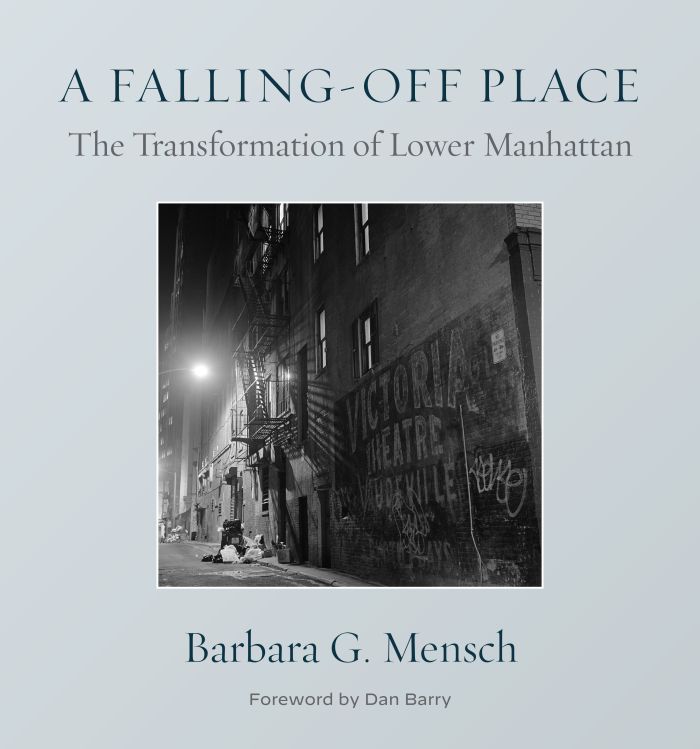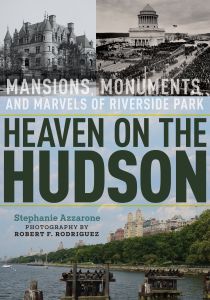A Falling-Off Place
The Transformation of Lower Manhattan

This book can be opened with

Photographer Barbara Mensch’s rediscovered photo archives and interview tapes capture symbolic transformations of Lower Manhattan.
Many of these images are published here for the first time. The photographs evoke the passage of time by dividing the images into three parts: the 1980s, the 1990s, and the new millennium (2000 and beyond). The photographer shares with the viewer:
“I would shoot ruins of buildings, the demolition of famous waterfront saloons, ancient alleyways, and, in some cases, nineteenth-century buildings destroyed by mysterious fires. There were images of floods and other calamities/catastrophes in Lower Manhattan, culminating with 9/11.
These photos captured what had been, what no longer exists. They served as my visual timeline. What did the passage of the many decades reveal to me? What dynamics were in my images of the same streets I repeatedly walked for years?”
The author’s images from the Fulton Fish Market in the 1980s document the generations of immigrants and their children pursuing a gritty American Dream next to the Brooklyn Bridge.
Photos from the 1990s present images of floods and fires that paralyzed the area, juxtaposed with continued bulldozing to clear the way for luxury housing. Politics reshaped Manhattan’s skyline by encouraging new commercial shopping, food, and restaurant destinations. This restructuring marked the beginning of the end of downtown’s blue-collar origins and white-collar replacements, challenging us to ask, “What was lost?”
The seminal event of the 2000s, September 11, 2001, reinforced downtown’s rebirth as the global economic engine with no room for the past. Also included in this section is an interview with an insider privy to the Mafia leadership of the Fulton Fish Market during Mayor Rudolph Giuliani’s opportunistic crusade against them in the 1980s.
Dan Barry, Pulitzer Prize–winning journalist, offers a poetic and insightful tribute to the artist and photographer.
“Definitions: ‘falling off’ suggests a decline in quality or quantity, ‘falling off’ suggests the passage of time or changes over time, ‘falling off’ suggests a detachment, an alternative path to a questionable destination, ‘falling off’ suggests a separation, ‘falling off’ suggests something that comes to pass.”
There is Barbara Mensch, whose images are like the conjuring rain. She is the Brooklyn Bridge of the New York imagination, linking the now and the then. She sees the incremental turns in the city’s inexorable evolution.—Dan Barry, The New York Times
Barbara Mensch's A Falling-Off Place features a variety of extraordinary photographs, ranging from images of demolition, to men at work, to abstract interiors, and to individual portraits. Like Jacob Riis in the 1890s, her work documents the material reality of New York in an unprecedented way. And it offers a vision of the relentless physical transformation of the city and its impact on working people and their labor.—Daniel Czitrom, author of New York Exposed
Photographer Mensch documents the upheaval of downtown New York City’s working-class and immigrant communities from the 1980s to the 2000s with images of disasters and bulldozing.—Publishers Weekly, Fall Announcements
In this striking collection, photographer Mensch traces three decades of change on Lower Manhattan’s eastern waterfront, paying particular attention to the Fulton Street Fish Market.
—Publishers Weekly
The beautiful images, often rich in chiaroscuro rendered by streetlights illuminating rainy nights or misty mornings, are complemented by quotes from residents and workers who provide insight into life in Lower Manhattan prior to gentrification.
Visually evocative and spare on text . . . It’s ideal for anyone nostalgic for old New York.
A falling off can indicate decline or diminishment, often gradual—the petering out of a business, for instance, or the decay of a once marvellous building. Or it can refer to something abrupt, absolute. . . Both senses haunt Barbara Mensch’s photographic history of lower Manhattan, in particular the Fulton Fish Market, which, for a time, was an island unto itself.—The New Yorker
Mensch returns us to the grimy, long-vanished world of ice haulers, unloaders and fish mongers—the denizens of her remarkable 2007 volume, South Street, but with the added, wider view of a disappearing Downtown that would follow. While not the sort of extensive, visual rumination on loss that photographer Danny Lyon brought to The Destruction of Lower Manhattan, Mensch offers a sort of visual postscript to her valuable documentation. Many of the images are of a Downtown coming down, in advance of its residential renewal.—The Tribeca Trib
An epic narrative . . .[A Falling-Off Place] takes an affectionate but unflinching look at Lower Manhattan through
—The Broadsheet
three eras: the 1980s, 1990s, and 2000s.
From time to time, we like to look back on how New York has changed over the years, and there's a new book of photographs that does just that. A Falling-Off Place documents the transformation of Lower Manhattan from a working man's neighborhood to downtown's rebirth after 9/11.—CBS News
Barbara Mensch joins MetroFocus to share many of her stunning black and white photographs in her new book A Falling-Off Place: The Transformation of Lower Manhattan.—PBS, Metro Focus
You can practically smell the tobacco and the brackish aroma of stale seawater. No city changes quite as fast or as frequently as New York. Mensch provides the city with a memory…—Avenue Magazine
Alison Stewart: When you describe it as a 'falling-off place,' what does that mean?
—Alison Stewart, All of It, WNYC
Barbara Mensch: 'This is the miracle and mystery of the creative process. I started thinking about certain playwrights like Thornton Wilder, I thought about Our Town. I thought about community and sense of place. This idea of falling off is also a metaphor for something that's uncertain, or time passing. I said, 'That's the title.'
vii | Foreword by Dan Barry
1 | Introduction
5 | Part 1: The 1980s: Making a Living on the Waterfront
49 | Part 2: The 1990s: Setting the Stage for a Real Estate Boom
71 | Part 3: The New Millennium: Managing Change
100 | Talking about the Old Days
115 | Acknowledgments




